How to Implement Quiet Vacationing Policies

Sorry, there were no results found for “”
Sorry, there were no results found for “”
Sorry, there were no results found for “”
Have you ever wondered whether those stunning white-sand beach backgrounds are actually real life for some coworkers? With ‘quiet vacationing,’ it’s a possibility!
A growing number of workers—particularly Gen-Z and millennials in remote roles—are choosing to work from vacation destinations, mixing work and leisure in ways we’ve never seen before.
According to a recent CNBC report, nearly 46% of American workers don’t use all their allotted PTO benefits, preferring to work while vacationing.
The emergence of quiet vacationing reflects changing perspectives on work-life balance. It also suggests a redefinition of traditional workplace norms and a growing need for employers to adapt to new worker expectations of flexibility and work culture.
Read on as we explore the phenomena of quiet vacationing and find ways to help teams achieve a better work-life balance. 🏖️
Quiet vacationing is the act of taking a break from work without completely disconnecting from work responsibilities. It does not typically involve requesting PTO (paid time off) or formally notifying the employer, as the employee still meets their obligations at work.
At its core, quiet vacationing involves working from your vacation destination—while still finding time for vacation-time activities between work. It offers workers the freedom to escape when necessary without using their allotted vacation days.
Employees who engage in quiet vacationing might:
In many high-stress or competitive roles, employees may want to take time off without appearing less committed at work or risking job security. If these employees perceive that taking official PTO might be looked upon unfavorably by their manager or colleagues, they may choose quiet vacationing instead.
Quiet vacationing gives them the chance to:
Quiet vacationing may reveal underlying problems in the workplace culture, such as issues with work-life harmony, transparency and communication, and workload. It could also indicate the inability of some workers to disconnect from work.
A recent Harris Poll found that 64% of millennials find it challenging to fully detach from work during their time off.
When employees resort to unconventional methods to take breaks, it may signal a need for improved leave policies and a culture that values and even encourages paid time off. Poor or misleading communication about vacation plans can lead to distrust and resentment between colleagues and gaps in work output.
From an employer’s perspective, supporting quiet vacations can be a strategic decision. Many organizations now allow employees to ‘work from anywhere in the world’ for a month or two or even indefinitely. This strategy works as an incentive to hire and retain highly sought-after employees while improving the overall employee experience and work-life balance.
The truth is that most of us return from meaningful, restorative time off with increased energy levels, fresh perspectives, and a positive outlook. Creating clear, employee-friendly policies around quiet vacationing demonstrates a company’s commitment to employee well-being and can help boost productivity.
Let’s face it—what matters most is that the work gets done and your co-workers are reachable when you need them. Whether they work under a beach umbrella or from the comfort of their home shouldn’t overshadow the value of their contributions.
Quiet vacationing presents a complex situation that’s unique to this time in history. It exists largely because many of us work jobs that can be done with a laptop and a stable internet connection. Expectedly, it comes with advantages and disadvantages for employers and employees.
While taking a peaceful getaway can be highly rewarding, it raises ethical considerations. One concern is the unequal access to these working vacations. Not all employees may have the financial means to afford quiet retreats, leading to disparities in who benefits from such opportunities.
There’s also the concern that quiet vacationing results from employees feeling pressured to always be available.
In demanding professions, the most valued employees may feel guilty about requesting time off, contributing to a culture of ‘vacation shaming’ or ‘vacation guilt’ where peers or supervisors subtly discourage breaks.
This can undermine the true purpose of a quiet vacation: to provide stress relief and a refreshing change of scenery.
Let’s run through the pros and cons of quiet vacationing.
💡Pro tip: Promote effective time management among employees by encouraging them to use productivity-tracking tools. Provide tips and resources to help them prioritize tasks, minimize distractions, and optimize work efficiency.
Remote work allows employees to work from anywhere, whether that’s a beach in Barbados or a coffee shop down the road.
Thanks to this freedom, remote workers are increasingly drawn to calm and serene destinations where they can unwind while staying connected to their professional responsibilities and networks.
The ‘work from anywhere’ lifestyle is especially appealing to those who enjoy exploring new places. For nature lovers, this could mean making a living while surrounded by pristine natural landscapes. For others, it could be immersing themselves in a foreign city every few months.
As long as their work doesn’t suffer, quiet vacationing is a happy indulgence for many remote workers.
As more employees dabble in quiet vacationing over traditional vacations, HR teams face the task of balancing employee well-being with organizational productivity and communication needs.
If this is a growing trend in your company, perhaps you need to rethink how your policies and workplace culture value uninterrupted relaxation and mental recharge. Policies that center employee well-being enhance employee satisfaction, performance, and loyalty.
However, when addressing quiet vacationing, you also have to account for organizational goals around workflow continuity, managing workload distribution, and ensuring equitable access to vacation benefits across the workforce.
Here are some strategies for HR to address this trend:
💡Pro tip: Implement HR software analytics to monitor workloads and communication patterns. Look for productivity or communication frequency changes, indicating employees are taking quiet vacations.
ClickUp for Human Resources is a project management tool that enables HR teams to manage quiet vacationing by promoting better time management among employees, leading to a healthier balance between personal and professional lives.

Use ClickUp Dashboards to proactively manage workload balance, monitor training progress, and gauge employee morale in real time. With workforce analytics and employee performance data, you can stay ahead of potential burnout triggers and create a supportive workplace where quiet vacations aren’t necessary.

Manage employee leave requests efficiently to prevent employee overload and avoid vacation conflicts for a balanced approach to reducing workplace stress.
Create custom ClickUp Goals for each employee with clear and measurable targets. You can align these goals with the overall organizational Objectives and Key Results (OKRs), ensuring everyone is working toward the same strategic objectives and achieving measurable outcomes instead of ‘busy work.’
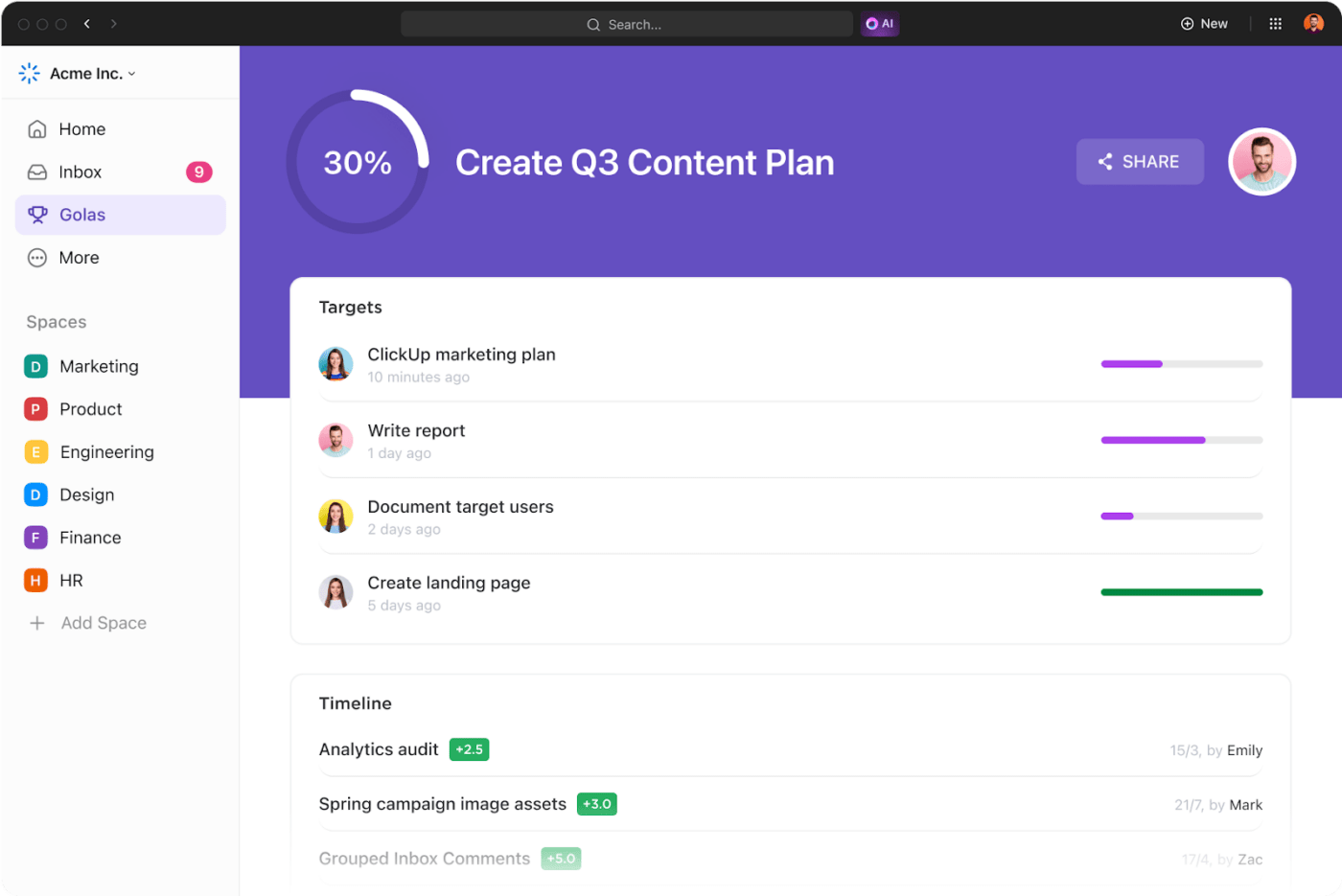
ClickUp Custom Task Statuses like Completed, Off Track, On Track, Not Started, and At-Risk provide a clear picture of each employee’s performance.
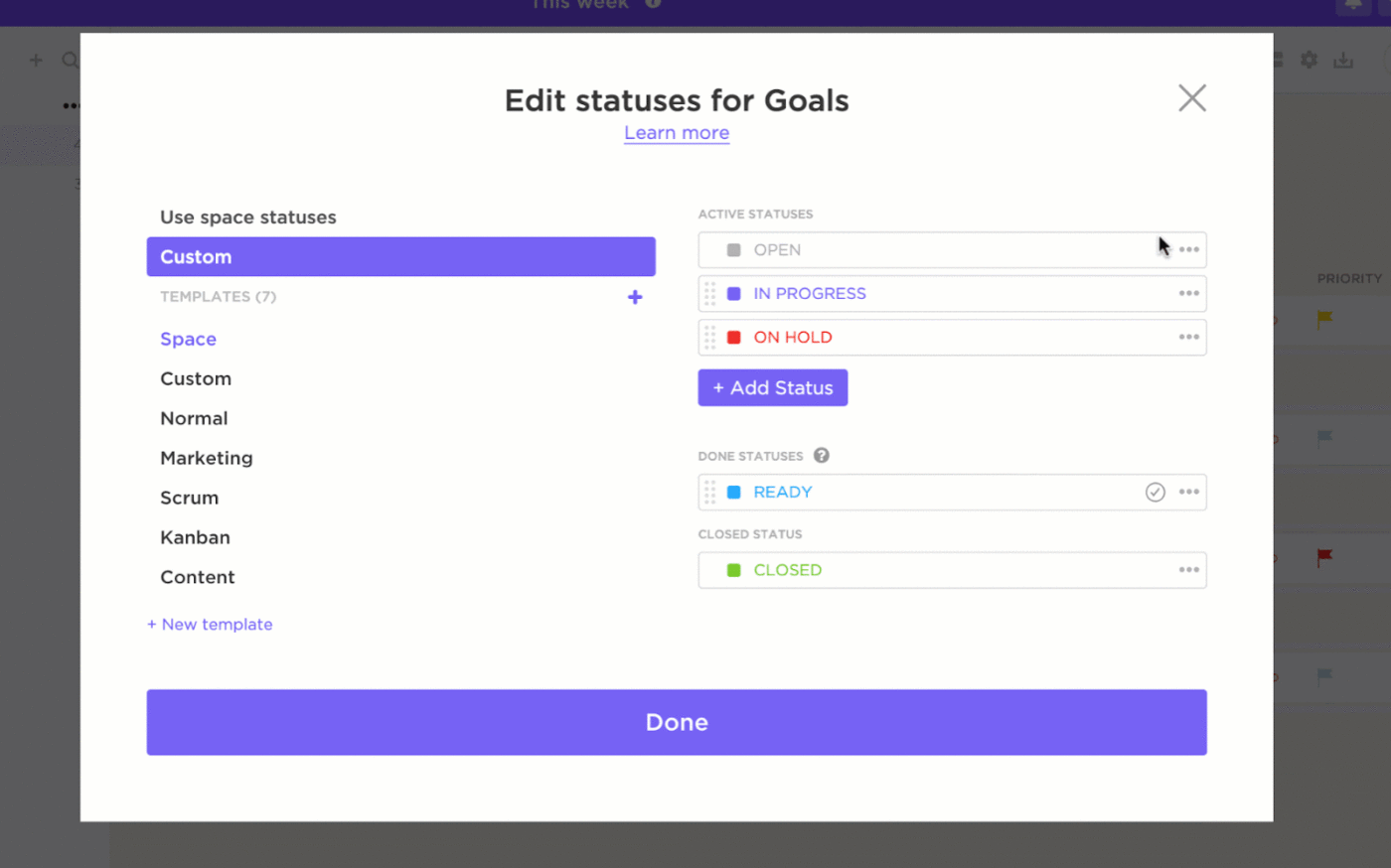
Collaboration tools like ClickUp Chat View allow team members to provide feedback and track task dependencies, maintaining accountability and ensuring that work continues seamlessly.
Dependencies are crucial for employees and leaders to understand how reduced capacities in one team may impact the larger team or ongoing projects. They are a useful metric to have when planning vacations or changes in regular working hours.
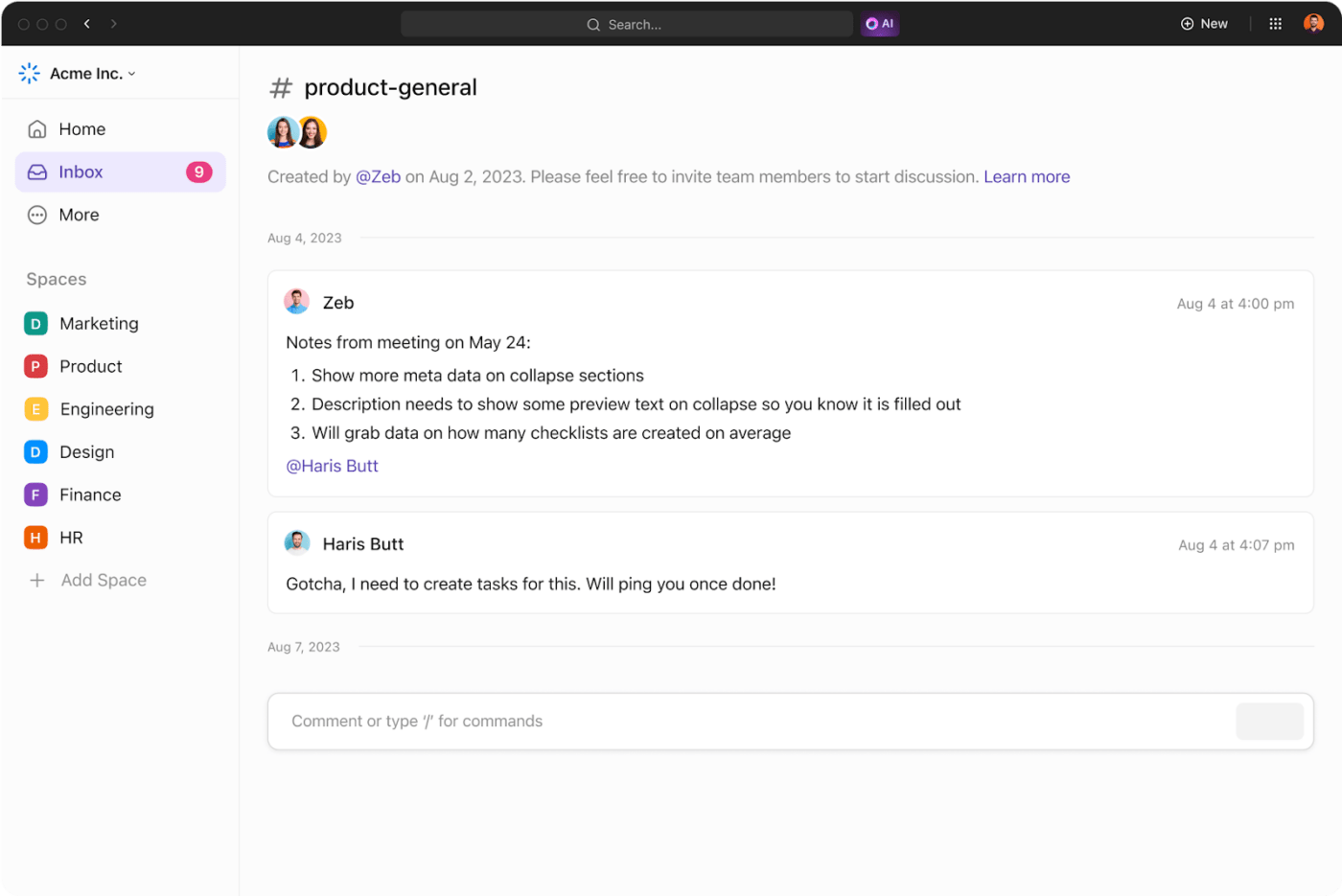
ClickUp’s Project Time Tracking capabilities are invaluable for monitoring how employees spend their time and identifying productivity killers. This comprehensive tool allows teams to record time seamlessly across different devices—desktops, mobiles, and web browsers—ensuring flexibility and accessibility for all users.
ClickUp also provides comprehensive time sheets that display tracked time by day, week, month, or custom ranges, offering insights into individual and team-wide productivity trends.
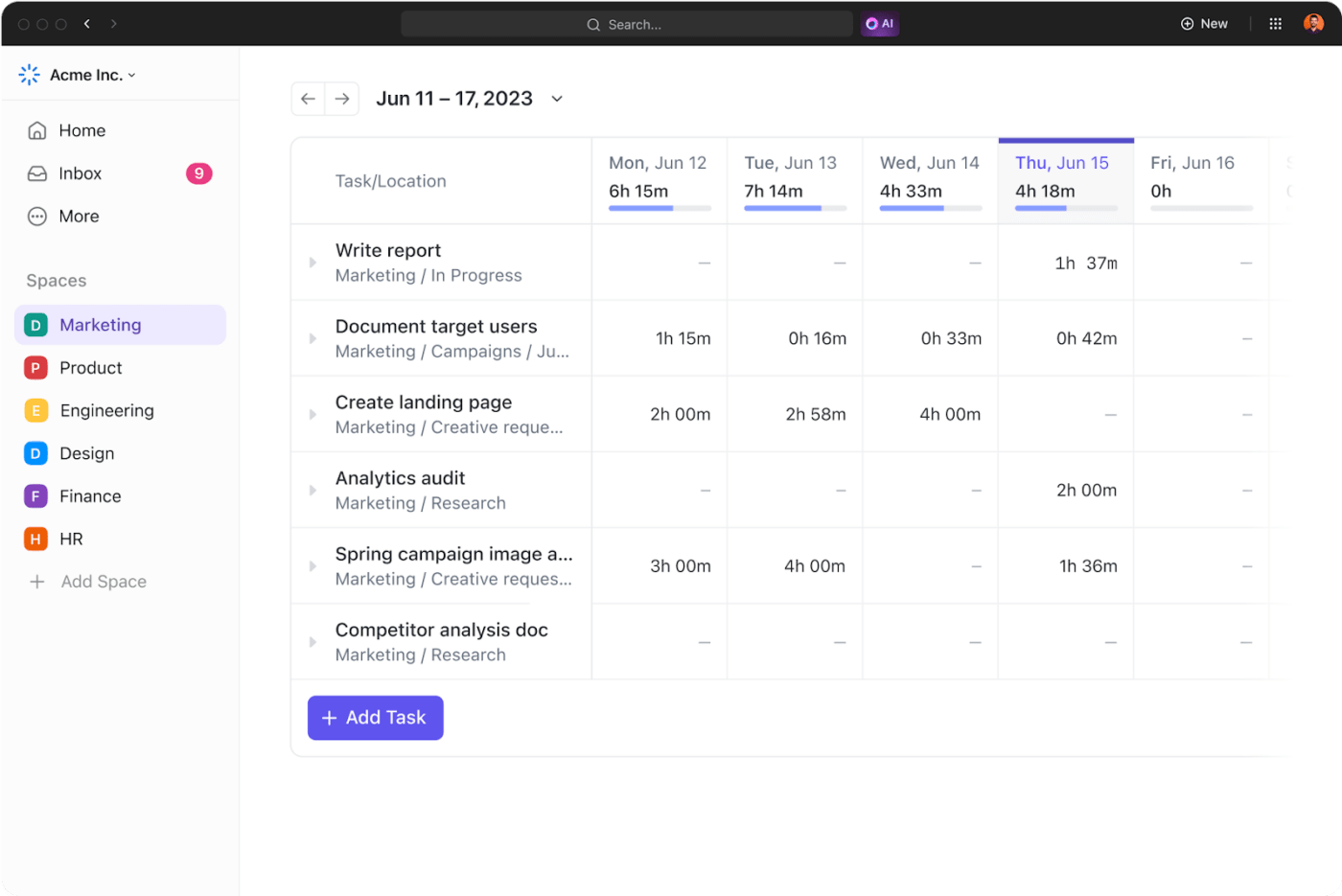
By enabling HR professionals to monitor and manage how time is spent across projects, ClickUp helps ensure that workload distribution remains balanced and manageable. This proactive approach helps mitigate last-minute rushes and unexpected workload spikes, which can negatively impact employee morale.
HR professionals play a crucial role in shaping workplace culture and ensuring employees follow clear, well-documented policies. ClickUp Docs is an invaluable tool for creating, organizing, and maintaining these essential documents.
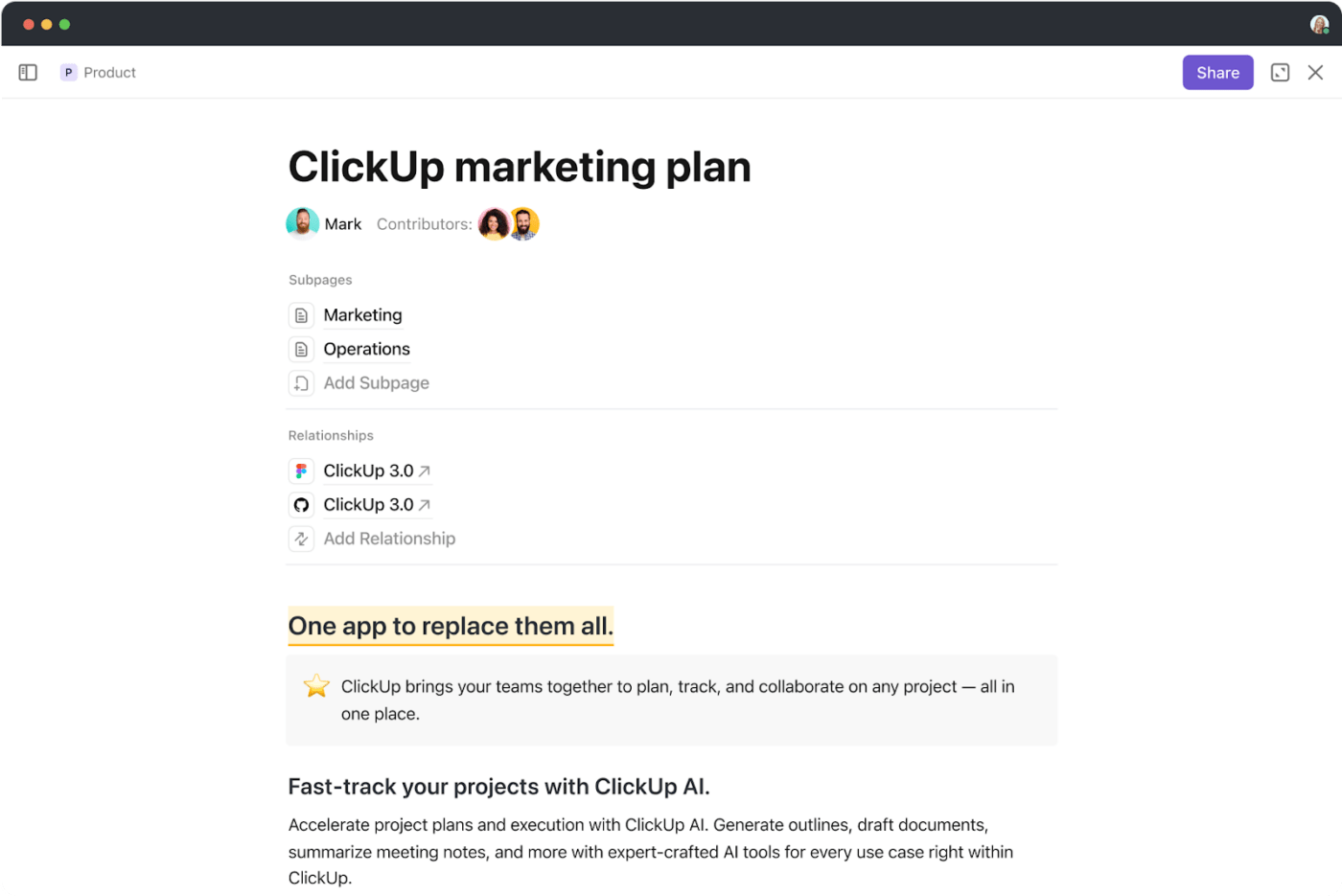
Using Docs, HR professionals can collaboratively create detailed guidelines that outline the expectations and processes for quiet vacationing.
The real-time collaboration feature allows multiple team members to contribute, ensuring the policy is comprehensive and incorporates diverse perspectives.

For drafting PTO guidelines, Docs offers robust organizational features that help structure the document logically.
HR teams can create sections for different types of leave, eligibility criteria, application processes, and FAQs. This helps ensure all employees know how to request paid time off for a stress-free experience.
Beyond vacation policies and PTO guidelines, Docs is also helpful for drafting various employee guidelines, such as remote work policies, code of conduct, and performance review procedures.

The ability to link to other documents or resources within ClickUp ensures that employees can access all necessary information in one place, making it easy to navigate and understand.
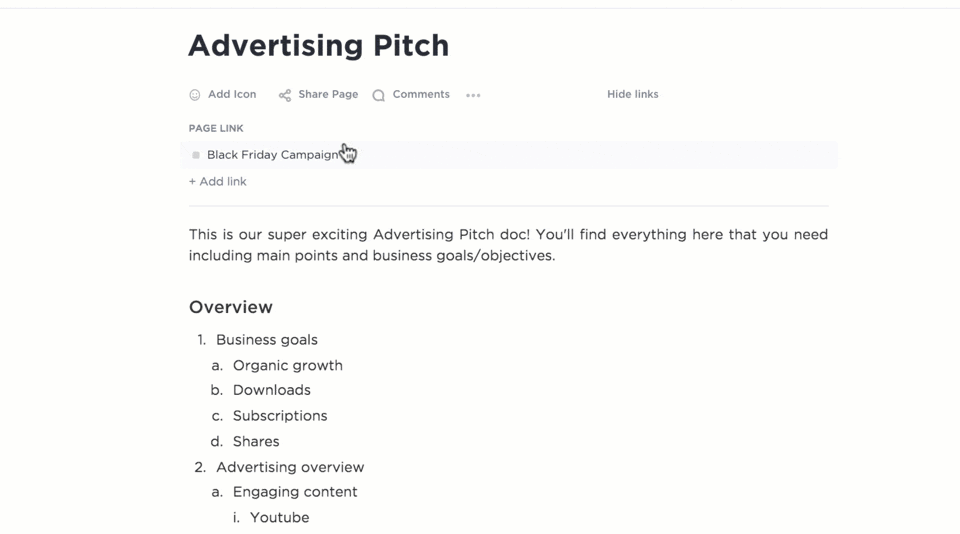
A thriving workplace thrives on solid employee handbooks, policies, and procedures. These documents and templates outline clear guidelines and instructions, helping everyone understand how to do their jobs effectively.
The ClickUp Employee Handbooks, Policies & Procedures Template
The ClickUp Employee Handbooks, Policies & Procedures Template is a valuable tool for consolidating all essential information, from payroll to vacation policies, into a single document.
This template sets clear guidelines for employees, reduces ambiguity in handling various scenarios, decreases the possibility of mistakes and misinterpretations, and promotes a safe work environment.
To maximize the benefits of this template, start by creating separate projects for each document. Assign specific tasks for policy development and collaborate effectively with stakeholders. Categorize tasks for efficient tracking and set up notifications for updates.
Conduct regular progress meetings and closely monitor task completion to enhance productivity.
ClickUp’s Employee Workload Template
Efficient project completion hinges on aligning task demands with your team’s capacity. Capacity planning is the process of effectively scheduling and allocating resources and time to ensure optimal operation and performance.
ClickUp’s Employee Workload Template is your go-to tool for effectively overseeing individual and team workloads.
Use this template to streamline operations, foster team unity, and empower staff with clarity and deadlines. Make informed decisions based on employee capacity insights.
Benefit from various workload views to avoid overwhelming tasks, organized statuses for tracking progress, instant notifications for up-to-date information, and analysis tools for peak productivity.
What are your employees’ thoughts on management, company culture, pay, benefits, and the overall workplace environment? Are they content or facing challenges? Do they need more support?
With an effective feedback tool, you can seamlessly collect, monitor, and address employee input to nurture a culture of development and mutual trust.
The ClickUp Employee Feedback Template streamlines communication between managers and employees, ensuring valuable feedback collection, tracking of employee sentiment, and fostering a culture of openness and trust.
It facilitates structured feedback delivery from managers, empowers employees to drive their performance, and encourages peer recognition and rewards for accomplishments.
With customizable progress statuses and 16 detailed attributes, including feedback importance and cultural insights, it offers four specialized views for enhanced tracking efficiency.
ClickUp Time Off Request Template
The ClickUp Time Off Request Template encourages employees to take breaks, simplifies leave tracking, minimizes administrative duties, and ensures fair time off management.
With features like Custom Task Statuses (Approved, In Review, New Request, Rejected), detailed information fields, and various viewing options for organization and accessibility, everyone stays in the loop about who’s out of the office at any moment.
Advanced tracking abilities through project management tools like task dependencies and tagging further enhance this capability.
Love it or hate it, quiet vacationing exposes several truths about today’s work culture: The demand for round-the-clock availability induces anxiety in employees when seeking time off, which can also drive quiet quitting; the fact that some employees can do their jobs well and meet their goals from literally anywhere; and, in some organizations, it’s more important to look busy than be busy.
Promoting organizational transparency and a balanced work-life can address this workplace trend. Employees who receive support and have manageable tasks are more inclined to engage in healthy vacationing practices.
ClickUp for Human Resources empowers effective workload distribution and clear communication, creating a positive work environment. Use it to track employee performance, engagement, and progress to align your workforce effortlessly.
With a vast array of pre-designed templates by ClickUp, you can ensure your employees stay motivated and engaged. Try ClickUp for free today!
© 2025 ClickUp